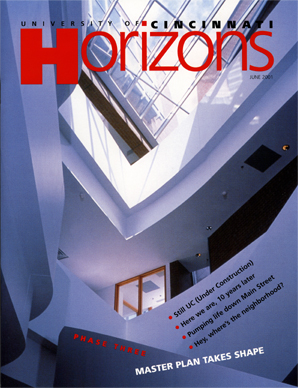Keep it up
In my administrative career, I have worked at six different universities in as many states and have had the opportunity to receive many university publications similar to UC's "Horizons" magazine. By far, the "Horizons" publications are the best ones I've seen in my many years in higher education. The articles are well researched and written, and the photography is always exceptional. Please keep up the great work. "Horizons" makes me proud to be a UC employee.
Paul Michaud
UC Associate Vice President
Human Resources
Enlightening
For those of us alumni who live far from Cincinnati and who do not return to campus often, the "One Day: University of Cincinnati" feature in the last issue of "Horizons," based on WCPO-TV's special documentary, enlightened and generated pride in UC. Informative and artistically presented, the article portrayed a capsule of life that would be useful to anyone seeking a better understanding of the university.
Perhaps the visual and written material that was used in preparing both the TV production and the magazine article could be compiled in a hardback publication that would be available for purchase, placement in libraries and recruitment of potential students. Should such a publication be created, it should include displays of UC students working at university-related co-op assignments worldwide. UC's pioneering program needs to be prominently promoted.
Fredrick Falls, DAAP '70
Mansfield, Ohio
Films with Sid
I fondly remember going to the Student Union on Wednesdays at noon, I believe, to listen to Coach Sid Gillman tell us what went right or wrong on the previous Saturday's football game. ["Gillman's Greatest Hits," January 2000]. He used his game films to show us what he wanted the team to do and assured us that the next game would show improvement. Since I played cards with some of the football players during the week, it made it much more interesting. I learned a lot about how the game of football should be played.
Glenn Varney, MS (Eng) '57
Cincinnati
Lost now found
The young man in the "On Campus Yesterday" photograph [January 2001] is 1969 College-Conservatory of Music graduate Mike Morton. Mike is a native Cincinnatian and a '65 graduate of Western Hills High School. When I last spoke to Mike in 1990, he was living, working and performing in the Chicago area.
Sharon Luth Fenicle, DAAP '70
Via the Internet

 Past Issues
Past Issues![CCM student Michael [Morton] Laird seated. on campus photo](https://magazine.uc.edu/issues/0601/letters/jcr%3acontent/MainContent/textimage/image.img.jpg/1325712260896.jpg)